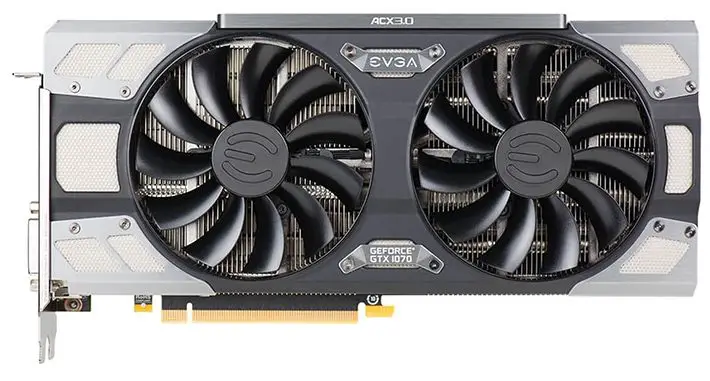
We would like to be able to show the shipping container and accessories that accompany the EVGA GeForce GTX 1070 FTW DT but as ours was not a retail sample, and rather was a gently used card that we snapped up recently, we are unable to. What we can say is that based on firsthand experience both the shipping container and accessories included are classic EVGA. That is to say very, very good.

As we went over in the introduction the De-Tuned For The Win series is neither fish nor fowl nor good red meat… and that confuses a lot of people. Basically, you can expect to get an incredibly robust video card that was built from the ground up for the demanding overclocking enthusiast but the GPU itself may not live up to the For The Win brand. What you can assume is to get at the very least as good as a reference card’s performance – and that is being incredibly conservative.
Since coming across this particular version we have used numerous of them and each and everyone will exceed all but the highest of expectations. When mining (as this is one of the most demanding tasks this side of synthetic ‘card killer’ applications) a EVGA GeForce GTX 1070 FTW DT will hit and stay at 1860MHz range day in and day out. Under less demanding circumstances they routinely peak at 1870MHz. To put this in perspective a EVGA GeForce GTX 1070 FTW non-DT will run at about 1890 (and peak higher), while a reference card will only run at about 1810MHz. Further narrowing it down an EVGA GeForce GTX 1070 SuperClocked will usually land in the 1830MHz range.

Put another way the EVGA GeForce GTX 1070 FTW DT will at stock settings net you a lot more performance than a reference 1070, a bit more than an EVGA GeForce GTX 1070 SC, and only a bit less than a EVGA GeForce GTX 1070 FTW. Of course, an EVGA GeForce GTX 1070 FTW2 ICX will go even higher, but those cards are ICX based and are entirely different breed all together… so expect to pay even more for them than the EVGA GeForce GTX 1070 FTW DT.
So how is this possible at stock clocks? Simple. This card is a For The Win card. The GPU just is not up to FTW standards and will be anywhere from 1Mhz below passing all the way to reference specifications bad. Most however are on the upper end of the spectrum. More importantly while they are only certified at reference speeds the rule of NVIDIA self-overclocking is the cooler they run the faster the run so the cooling solution paired to the GPU is almost as important as the GPU itself.

This is why EVGA thought it was a good idea to label them “FTW” as they do get the full FTW cooling treatment. This means two large ball-bearing fast cooling fans attached to a rather large – for a dual fan – cooling solution that makes use of massive heatpipes as well as an oversized fin array.

Of course, the down side to using a ‘taller’ cooling solution is that in smaller cases this card will not fit but most cases this is a non-issue (as it is tall but not as tall as some from other manufactures).
More importantly, for some, is the EVGA GeForce GTX 1070 FTW DT comes equipped with the self-same dual BIOS option, and the FTW LEDs. We can on our thumbs the number of times we have needed to use the secondary BIOS to unbrick a GPU in the past couple years… but it is a nice little bonus.

What is also critically important, and a large part of why we like the particular DT card so much, is the fact that EVGA goes all in on the power delivery subsystem. Everything from an overkill 10+2 all digital voltage regulation subsystem to a dual 8-pin power input configuration. Two 8-pin PCIE connectors means this card can pull up to 300 watts from the PSU directly without ever needing to touch the PCIE slot.

We still would not power one in a mining rig via a SATA cable… but this is one of the few that are as close to ‘safe’ as we have seen. After all, NIVIDIA still does place a 120 percent power limitation on this card… and last time we checked 180 * 1.2 is a lot less than 300 watts… and less than the 215 watts EVGA specs the FTW ACX 1070’s at.

Also as an added bonus, all EVGA DT’s get that extra thick backplate that uses heatpads to help improve the cooling. This too helps reduce the temperature of the GPU and further improves overclocking.
As we will show you later in the review the DT’s are not really meant to be run at stock settings. Sure it can be (and when done is down right silent) but this card is meant for overclocking enthusiast who may not want to break any overclocking records but do want to squeeze even more performance from their new acquisition and turn a decent card into a great one. This is where the improved cooling, improved power delivery, and over-built VRM really start to pay dividends and further separates the DT from the SuperClocked class of GTX 1070s.











